A new series of WW2 Wings of Glory Airplane Packs is coming soon, introducing the Republic P-47, Messerschmitt Bf.109, Douglas SBD Dauntless, and Yokosuka D4Y Suisei airplanes in a new content format. Let’s learn something more about these planes, starting with the Republic P-47, the main United States fighter of World War II and the largest and heaviest single engine fighter built in World War Two.
The Republic P-47, also called “Thunderbolt” or “Jug,” served as a bomber escort and as a very effective ground attack fighter. It was designed in 1940 by Alexander Kartveli as the successor to a line of airplanes derived from the Republic P-35, developed by Alexander Seversky. Its original design was of a small, inline-engine lightweight interceptor, but during development the project changed to meet new requirements, and the prototype XP-47B, the first production version, weighed more than double the initial version, with increased armor around the cockpit and eight .50-caliber M2 Browning machine guns. A 4-stroke internal combustion Pratt & Whitney R-2800 Double Wasp engine gave it excellent performance and a large load-carrying capability – up to 2500 lbs. of externally-mounted bombs, rockets, or other free-fall ordinance.
The P-47 first flight was in May 1941, and while engineers worked to address some problems, the USAAF ordered 171 units. The design proved to be worthwhile, and quickly the initial order was followed by another one, for 602 more of the improved P-47C model. The first P-47s were delivered in June 1942, and by the end of that year most of the troubles had been worked out. The 56th FG, equipped with these planes, was sent overseas to join the Eighth Air Force. The early P-47s had a "razorback" canopy configuration with a tall fuselage spine behind the pilot, which limited the pilots visibility, and new versions with an all round vision “bubble canopy” started to be delivered in May 1944.
The Jug became renowned for its ruggedness, firepower, and speed, seeing service in nearly every combat theater. The P-47D was the most produced version with over 12,500 built. The widely-used model of the Thunderbolt, with almost 2 million flight hours during the war, accounted for over 7,000 enemy aircraft destroyed in the air and on the ground in Europe. It provided the backbone of 8th Air Force fighter groups in England and in the 15th Air Force in Italy, serving in the role of a long-range escort fighter. In the Pacific, the P-47 served as an escort fighter for B-29 bombers.
Many Allied countries also flew the P-47D in combat in WWII, including Brazil, Free France, Great Britain, Mexico, and the Soviet Union. In the post-war it continued to serve the air forces of over 15 countries for many years. In the US, it was flown by the Air National Guard for nine years following the war. A total of 15,677 P-47s were built, and nine of them are still airworthy.
The three P-47D Thunderbolt featured in WW2 Wings of Glory, all of them Razorback versions, are the planes piloted by the Lts. Charles D. Mohrle and Elwood D. Raymond, in the European front, and a plane used by the RAF 135 Squadron in the Pacific. The T maneuvre deck used by the P-47 is not particularly agile, but it is among the quickest in the game: no other released plane can outrun it. With 21 points of sustainable damage, the P-47 is also the sturdiest fighter ever released in the game. The Jugs of Mohrle and Raymond come with the additional card “Large drop tanks,” indicating these airplanes may be equipped with Drop Tanks to carry additional fuel (up to 24 points of fuel), and the instructions on how to use this feature in the game. For the RAF version, there is a similar card, “Drop Tanks,” with a capacity of 16 points of fuel.
Charles D. Mohrle (510th Fighter Squadron, 405th Fighter Group)
Charles D. Mohrle was born in Oklahoma City, in 1921. He joined the US Army Air Force in February 1942, and was assigned to the 510th Fighter Squadron, part of the 405th Fighter Group, which entered combat in Christchurch, England in 1943. Flying a P-47, he performed 97 combat missions, including air support for the D-Day landing, destroying enemy planes and trains, and helping clear the way through France for Gen. George S. Patton’s Third Army. Mohrle received the Distinguished Flying Cross and 16 Air Medals.
Returning to Dallas after the war, he worked in an insurance company and as an advertising artist. After retiring, he became a volunteer at the Frontiers of Flight Museum, where he used to make presentations and talk about his wartime experience. He died at 92 years old, on May 8th, 2013. In an interview posted on YouTube by Erik Johnston, for the Veteran Tales Project, Mohrle told his story of flying the Jug during WWII.
The P-47 Thunderbolt piloted by Mohrle was nicknamed “Touch of Texas” and was decorated with a rattlesnake head, complete with glistening fangs and glaring yellow eyes. In Wings of Glory, his airplane comes with a skill card “Lucky pilot,” which allows the pilot to choose to ignore a single damage counter during the game, after drawing and seeing it.
Elwood D. Raymond (63rd Fighter Squadron, 56th Fighter Group)
Elwood D. Raymond, from New Jersey, was a 2nd Lieutenant of 63rd Fighter Squadron, part of the 56th Fighter Group, known as “the Wolfpack.” The 63rd FS was the first to be equipped with the Republic P-47 Thunderbolt, in late May, 1942, and the 56th Fighter Group the only one to fly the P-47 continually throughout its service in Europe during WW2. It was also the Fighter Group that destroyed more enemy aircraft in air combat than any other – 674 enemy aircraft on air, 332 on ground claimed, with 678 tons of bombs dropped.
The 2nd Lt. Raymond was killed in action during the worst day of the 56th Fighter Group, September 18th, 1944. During a mission in support of the operation Market Garden, in Arnhem, Netherlands, sixteen pilots failed to return; one of them was Raymond, who died after his P-47 crashed into North Sea. For this mission, the 56th Fighter Group was awarded its second Distinguished Unit Citation. Raymond was awarded with the American Campaign Medal, World War II Victory Medal, and Purple Heart.
In Wings of Glory, this airplane comes with the "Sniper" skill card. When this ace fires at an enemy airplane, he tends to hit a bull’s-eye.
RAF 135 Squadron
The No.135 Squadron Royal Air Force, formed in 1918, was reformed in August 1941 as a fighter unit equipped with Hawker Hurricanes, and started operations in January 1942, in Rangoon, Burma, against Japanese forces. After an enemy attack in Burma, almost all the squadron’s aircrafts were lost. Evacuated to Calcutta, the No.135 was reformed and retained in India, flying convoy patrols until January 1943, when it began air defense duties and sweeps over Burma. Beginning May 1943, the squadron acted as a conversion unit, re-training Blenheim squadrons to operate Hurricanes and then providing air defense cover for Southern India.
In May 1944, the squadron started to be re-equipped with Thunderbolts, and by the end of August it was completely equipped with the P-47. In October 1944, No.135 Squadron returned to operations carrying out ground attack missions against targets in Burma until May 1945. In June, it was withdrawn from operations and became No. 615 Squadron.
The No.135 had the motto “Pennas ubique monstramus” (We show our wings everywhere). Its insignia was a peacock and the squadron code WK. Its P-47 "Razorback" version featured in Wings of Glory, includes the skill card “Good at Escaping,” which requires the use of the Tailing optional rule; this pilot’s airplane may not be tailed, unless the tailing airplane’s pilot is also an ace with this skill.
Information sources: Warbird Alley, Military History, Aviation History, Wikipedia, War Thunder, 56th Fighter Group, Dallas News - Charles D Mohrle, Honor States - Elwood Raymond, Official RAF website - 135 Squadron, History of RAF Organisation. .

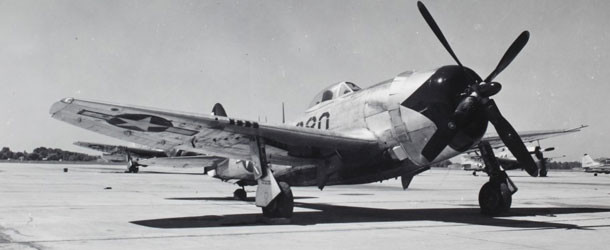
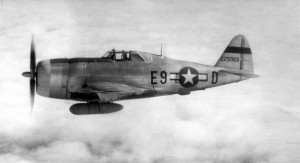
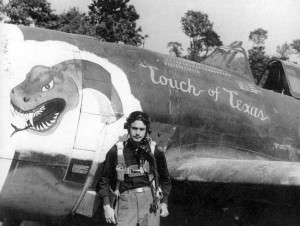
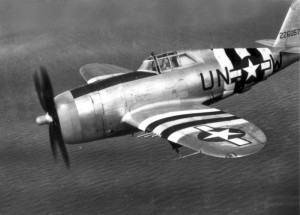
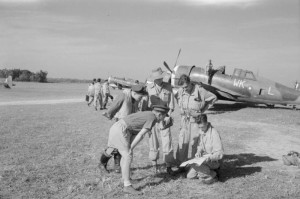
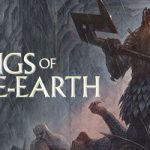

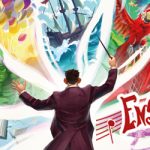
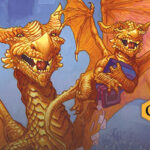




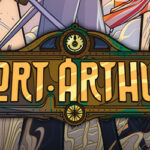
Follow Us on